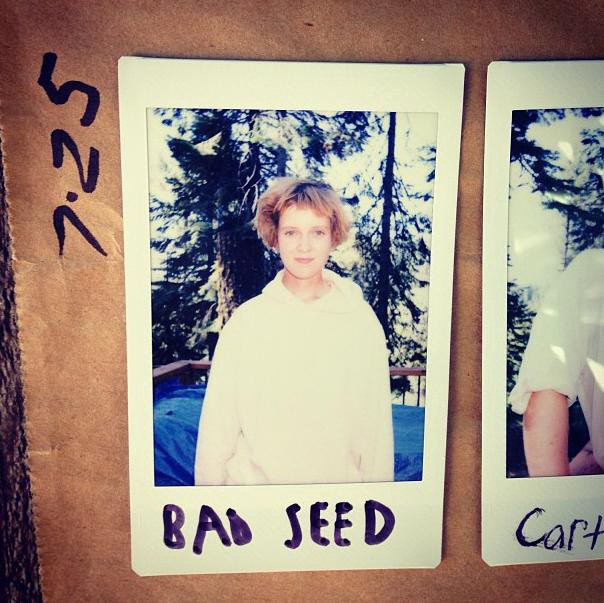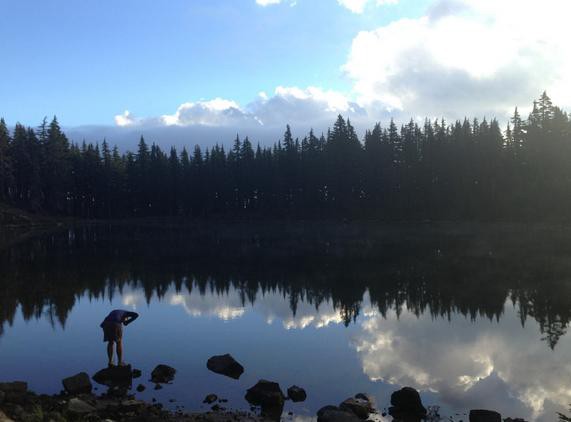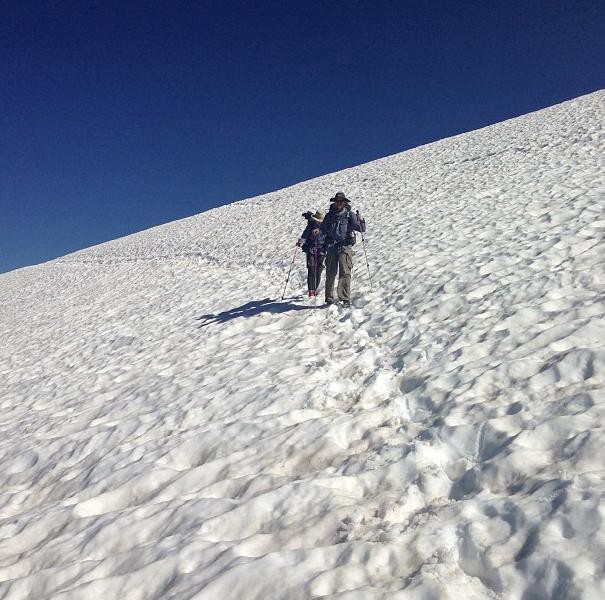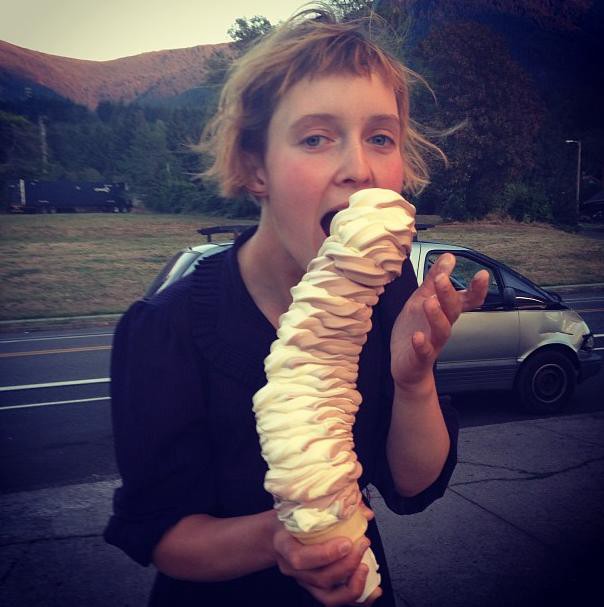Four Months Alone on the Pacific Crest Trail


Myla Fay is a 25-year-old woman who recently hiked 2100 miles alone. This summer, she plans to hike the Continental Divide Trail, all the way from Mexico to Canada.
How did you get into long-distance hiking?
I grew up in Maine and spent a lot of time outside, and when I was a kid, we went up to Blue Hill every summer to hike and swim, camping in Baxter State Park and backpacking in the White Mountains. And in high school I did some incredible trips with the Chewonki Foundation: one was a 400-mile white-water canoe trip that ended in the tiny Inuit village of Kangiqsualujjuaq in northern Quebec. I always liked the outdoors, and backpacking felt like a good fit.
I was also always interested in long-distance hiking as a more structured way of traveling. I spent a summer alone in India once and felt overwhelmed by all the decisions and planning involved in traveling. With hiking, your trip is organized around managing food and water and covering distance, and there’s less of an expectation for fun and relaxation. I like the part of backpacking that’s monotonous and challenging.
How long had you been thinking about hiking the PCT before doing it?
I heard about the PCT my senior year in college, but during and after college I was focusing on school and work: I worked as a designer in Minneapolis and New York, which I liked. Then I wanted to work on my own projects, so I moved back to Maine and set up a printmaking studio in the basement of a rural Zen Center. But it’s difficult to make any money from printmaking and it’s also difficult to live and work in isolation.
I felt unsure about what I wanted to do, so I made a list of things I never regret doing. I realized that I never regret spending time outside, traveling, and challenging myself, so I decided to hike. I don’t think any 90-year-old would look back on life and regret hiking the PCT.
Did you know you wanted to go alone?
I might have considered it if I had known someone willing to drop everything and go hiking for four months. But I liked the idea of hiking alone anyway. Being alone is wonderful because you never have to compromise. If I felt like swimming all day, that’s what I did.
How long did it take to get ready?
I only had about three months to prepare. Most people spend around six to 12 months getting in shape, dehydrating food, and planning. For me, I bought gear and read “Yogi’s Guide,” which has advice for thru hiking — tips for hitchhiking, choosing campsites, resupplying, etc. It also outlines motel and grocery options for each town. I bought my food in towns and mailed food ahead when the next town was too small to resupply.
Do you have to be in good shape before you start a hike like this? Or could you just tough it out and get better as you go?
You don’t have to be in good shape to start a hike, but it helps. It also helps to be young. No matter what shape you are in, hiking 10 to 12 hours a day is going to be hard. I thought that after hiking for a week or two I would just be “in shape,” but I was surprised that my fitness continued to improve.
I also never stopped having some degree of pain.

What was the gear you started with and the gear you ended with? Anything you packed that you realized was useless?
I started hiking in desert heat and ended my trip snowshoeing through six feet of snow, but surprisingly I used most of my gear in all situations. After a month I bought a solar charger on trail to charge my iPhone, which was a real luxury. I also bought a dress from Goodwill along the way. It was comfortable to wear hiking and convenient for peeing outside modestly.
I added various warm layers as I went north — a rain skirt (which is lighter, more breathable, and easier to put on than rain pants), an emergency blanket, snowshoes, long underwear, and bread bags to wear on my feet for warmth.
I eventually ditched my mace, bug spray, and a mouse-proof food bag because I felt they were unnecessary, but not everyone would agree. Now that I have a better idea of what I need, I revamped my gear for my upcoming trip on the CDT. I have a post on my blog about the new gear, and also have my gear list on my website, if anyone wants to read.
What about trail food? How’d you deal with it? Did you filter your water the whole time? What are the worst and best things you’ve tried on the trail?
Food was hard to plan for because my preferences and hunger changed constantly. Sometimes I had five extra pounds of food when I arrived in town and other times I ran out. One of the benefits of buying food as you go (rather than mailing it) is that you can easily make adjustments. I hiked with a girl who mailed all her food and by the end, she literally gagged every time she ate a Clif bar or oatmeal.
I think having a variety of food on trail is important. I cooked ramen with PBR once when I arrived at a road crossing where someone had left a few beers for hikers. I was out of water, so I used the beer, and it was surprisingly delicious. At the end of trail, I ate snickers dipped in cream cheese and I thought it tasted like chocolate cheesecake!
One of the worst things I tried was cold instant coffee mixed with oats. I was trying to pack up quickly in the morning and didn’t want to heat water. Needless to say, it was disgusting. I also once ate a spoonful of dry protein powder at night because I was starving and low on food. It felt similar to the cinnamon challenge.

How much more do you end up eating than normal? What are the cravings you develop after long hikes?
I ate a TON of food. Granola bars, mini pies, peanut butter, Nutella, tortillas, ramen, Cheezits, candy, muffins (squished), pop tarts, nuts, and anything else that caught my eye in the grocery store. All hikers fantasize about food, mostly about fresh fruits, vegetables, pizza, and ice cream. I daydreamed about Slurpees a lot. There is no food guilt on trail. All notions of what, when, and how much is appropriate to eat disappear. Instead of cutting calories and dieting, hikers worry about not eating enough. I ate 3,000 to 6,000 calories a day, and it was incredibly refreshing.
The downside of eating so much was the stomach aches. Sometimes I would eat a whole sleeve of Oreos, which tasted delicious, then I would feel awful for a while. It’s a lot to ask of your body, to process all that food.
Did you see a lot of other solo hikers? Did traveling alone made you more open to meeting random people?
Travelling alone does make it easy to meet people. Most hikers start alone, and many hike in groups for various lengths of time. When I started, I wanted to hike alone to challenge myself and rely on my own decisions. I became more open to meeting people over time, and by the end of trail I found a balance between independence and community.
Who were the coolest people you met along the way?
Everyone I met had an interesting back story — one couple worked in Antarctica, one girl sold her house to live out of a backpack, there were Marines who hiked to deal with PTSD, and people who left their high-paying jobs because they didn’t want to devote their lives to work.
One of my favorite characters on trail was a retired guy from New Jersey. He lived years without health insurance or hot water, and took ice-cold hose showers every day at home, even in the winter. He told only one person he was hiking the PCT and always camped alone far off trail. He didn’t own a phone, but carried a small radio to listen to baseball games. Every time he went into town to buy food, he bought a glass, because he only drank beer out of a glass. He was also a scavenger. Once in town I gave him part of a cookie and he just packed it away for later. Another time he told me that he carried a cube of bouillon for an emergency meal. I told him it didn’t have any calories, and he said, “But it sure does fill you up!”
I should mention that there are more men than women on trail, and most people I met were white and middle class, so unfortunately trail culture is not too diverse.

How many times were you ever truly scared, and why?
Most of the time trail felt very safe, but I had a couple moments of being spooked. I almost stepped on a rattlesnake. I once got lost looking for a spring at night without my pack. I got dangerously cold during a snowstorm. These situations were all preventable had I been paying better attention.
Some hikers do end up in truly scary situations. One girl had a mountain lion stalk her at night, and another guy ended up lost on a snowy cliff where he couldn’t go forward or backward.
Oh my god.
A lot of people on trail carry a SPOT device with an emergency button that activates a search and rescue response team. They are expensive and I personally felt safe without one, but a few people did use them on trail.
What about weather conditions? You had to hike at night sometimes because of the heat, right?
The PCT covers a diverse range of terrains and temperatures. In the desert, it reaches 110 degrees, and water sources are sometimes 30 miles apart. I carried 1.5 gallons of water at a time. Hiking at night is much cooler and requires less water, so many people hike early and late (resting midday). Night hiking is beautiful but spooky. Some huge bugs and rodents that come out at night.
And then there was the extreme cold: I’m reading a blog post where you did sit-ups in the middle of the night to stay warm. What’s your least favorite and most favorite weather to hike in?
I still prefer hiking in desert heat over the cold Northwestern weather. In Oregon and Washington, I dealt with rain, hail and snow, which is dangerous without adequate food and gear. Most people carry down jackets and sleeping bags, but down is useless when wet. When it is cold, taking breaks is not an option. I knew one couple who hiked over 24 hours without stopping because all their gear was wet and it was snowing. They would have become hypothermic if they stopped.
Can you tell me some hiker code? What’s the jargon like?
There are lots of phrases specific to thru hiking. Some are practical (“slackpacking” is hiking a section without a full pack, “hiker hunger” describes the extreme hunger after hiking, “vortex” is when you spend longer than expected in town). A lot of them are meant to be funny (“Vitamin I” for ibuprofen). “Cowboy camping,” sleeping under the stars, is one of my favorite terms. It’s basically a fancy way of saying “I am too lazy to pitch my tent and I doubt it is going to rain tonight.”
My friend “Scrub” has a more extensive list of hiking terms on his blog.

That’s his trail name: does everyone have one?
Everyone gets a trail name, usually given by another hiker. Part of the idea is that you can leave your other life behind and be someone new on trail.
And there’s other stuff like this: trail angels, trail magic, what does that mean?
A “trail angel” is anyone who helps you by offering “trail magic.” It could be a day hiker who gives you an apple or someone who drives you to town. There are established trail angels who help hikers each year by leaving food or sodas on trail or even opening their homes to hikers. There are also some trail magic events, where angels make burgers or pancakes on trail for a day or two.
It is hard to overstate how incredible it is to come upon fresh hot food or cold sodas after being out in the woods for a few days. The terms seem right.
How was your emotional state going into the hike, and during it? What was the default state of each day?
I was much happier on trail than I was prior to trail. Some of that may have had to do with the endorphins released from exercise. I also gained a lot of confidence in my body and my ability to troubleshoot difficult situations. By the end of the trail, I felt I could do anything. I certainly had moments of frustration, crankiness, and misery, but I always preferred trail to home.
Wow. What did you do to pass the time?
It wasn’t too different from regular life. Sometimes I listened to music or books, sometimes I worried about logistics, sometimes I wondered what to do with my life. I thought about family and friends and remembered things I had forgotten. Sometimes I played games with other hikers, sometimes I counted my steps, sometimes I brushed my teeth for an hour.
What are some good stories you heard on the trail from other people?
There was a huge snowstorm in Washington that coincided with the government shutdown, and some hikers decided to road walk the last 60 miles to Canada to avoid deep snow. Rangers stopped them because it was illegal to be in the park during the shutdown. So after hiking 2600 miles, they quit because of a triviality.
I also heard a story about a girl who saw a mountain lion sitting next to the trail. She roared at it, like you are supposed to (you never want to let a mountain lion know you are scared), then kept walking past it only to realize that there was a switchback in the trail and she had to pass it again.
And then, there was a funny story about a hiker I never met who found chapstick on the ground and used it for crotch chafing. A few minutes later a woman walked by and asked if anyone had seen her pina colada chapstick. From that point forward his trail name was “Penis Colada.”

That is a great story. What was your favorite part of the trail?
The last four days on trail were my favorite. I snowshoed on fresh snow through the most spectacular scenery on trail with a boy who I like very much. It was new and exciting and beautiful and romantic.
What about the least?
Southern Oregon was my least favorite part. Everyone talks about how Oregon is flat and easy, but my feet were hurting so it didn’t feel easy. In my opinion, it was also the least spectacular part of trail, just woods and ponds.
What was your favorite pit stop?
One of my favorite stops was Buck’s Lake, a small town in northern California. I got off trail to apply for a job. I didn’t end up getting the job, but I stayed with the most incredible trail angels. They were welcoming and made burgers with heirloom tomatoes and peach cobbler and fruit salad. They also took me out on their pontoon for sunset to drink white wine and listen to the Beach Boys.
What did you miss most while you were hiking?
Fresh fruits and vegetables, and my friends and family.
How did this hike physically affect your body?
I lost about 5 to 10 pounds by the end, despite gaining muscle. My breasts mostly disappeared and my feet grew a full size. Women usually lose less weight than men, which is an advantage on trail.

What about your hair?
My hair was crazy on trail. I was trying to grow it out, but it was a bad length for hiking: long enough to tangle and too short to pull back. I had dyed it before trail and wanted to let the dyed part grow out. I also decided to stop using shampoo, in part thanks to articles like this. Needless to say, my hair was a bleachy, greasy, tangled mess. I cut it off when returned home.
Before or after, did you have a lot of people telling you that they wanted to hike the PCT too? Or were people more like, “You’re nuts!”
A lot of people say something along the lines of, “Wow, that’s amazing! I could never do that!”
But hiking is kind of like drawing. People say they can’t draw, as if it’s a mysterious talent, but both drawing and hiking are just a set of skills anyone could learn. If you are interested in hiking the PCT or another trail, I would encourage you to go ahead and do it. I think it is almost always a positive experience, although returning to regular life is difficult.
People sometimes romanticize long-distance hiking, but I was just walking. Some people work 8 or 10 hours a day on spreadsheets or washing floors and few people say that is amazing.
What’s going to be different about your upcoming trip hiking the Continental Divide Trail?
The CDT is more challenging than the PCT for many reasons: more remote, fewer hikers, less time to finish, and tough to navigate. It’s also 1000 miles longer.
And you’re not doing it alone: how does that change the planning?
I will hike with someone I met on the PCT. There are pros and cons to hiking with others: our packs will be lighter since we will share some gear, and it’s also safer and will be a lot of fun, but I will miss the independence and solitude.
What’s your favorite picture from your PCT hike?

This is a campsite on an exposed ridge in northern California. The sky was smoky from a nearby fire, but I could see well enough to watch a meteor shower. It’s hard to choose one photo, but that was a good night.
You can follow Myla’s upcoming trip at mylahikes.com, or follow her Instagram and Twitter.